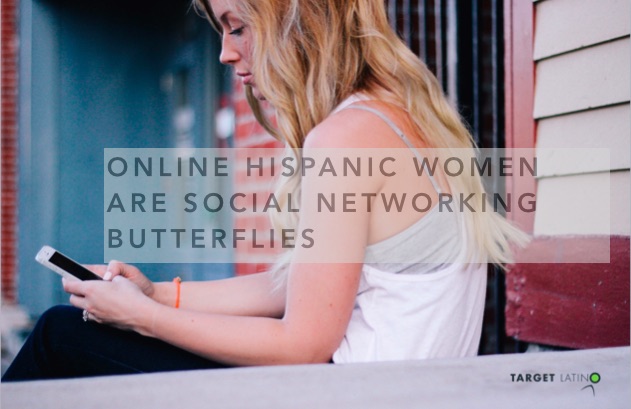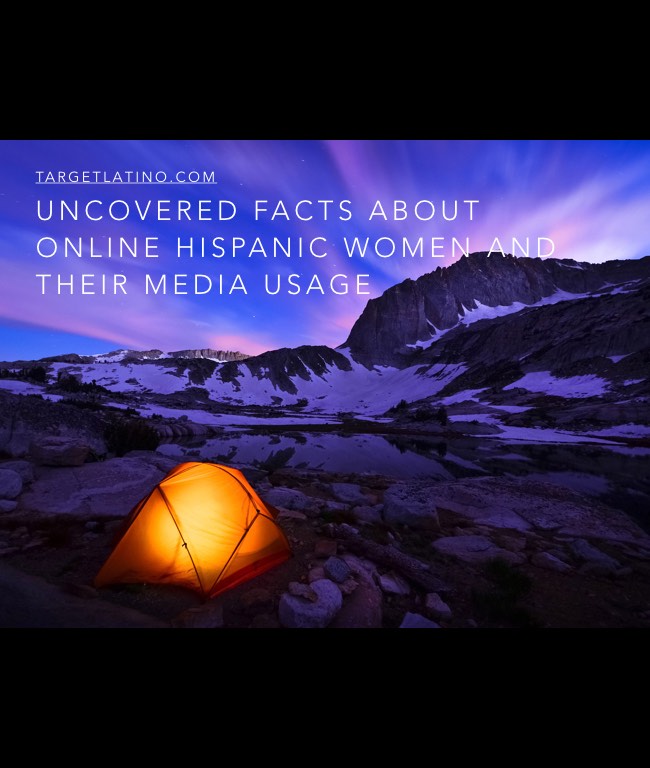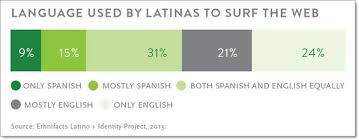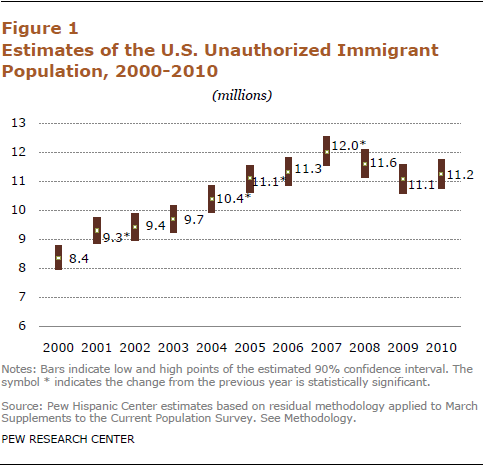Uncovered Facts About Online Hispanic Women and their Media Usage
Are you considering going after the online Hispanic women market? Here’s all your questions on their online media usage answered but to find out you must read every word of this comprehensive report.
One of the main factors that decisively affects business profitability and ROI is market share. The connection between market share and profitability has been recognized by scholars, business executives and consultants.
Hispanic women in the U.S will reach 51 million by 2050 and will make up 25% of the total U.S female population by 2050, according to Hispan Telligence.
If we add the fact that U.S. Hispanics are ahead of the curve when it comes to digital, they lead in adoption of new devices, are power users of mobile and over-index in video consumption, the conclusion is clear. It’s time to pay attention to the online Hispanic women market.
Hispanic women RULE in digital
Many brands believe that the only places to reach online Hispanic women are lifestyle magazines, celebrity gossip and mommy sites. While these sites are very effective in reaching them, Hispanic women trace their own path and can be found in other online properties in droves and we will cover these shortly. You just have to know where to look.
Online Hispanic women are social networking butterflies
Hispanic women of all ages engage in a multitude of online activities, such as blogging, photo-sharing, gaming, video viewing and instant messaging. Mobile social networking is a habitual practice in the lives of today’s women.
Social retail, clearly demonstrated by the percentage of women that participate on Pinterest and because it combines two activities that are already firmly embedded in the daily activity of online women, is the next logical step in this evolution.
Women transact online more than men
In the U.S., currently the largest e-commerce market in the world, women are the key drivers of online buying. More women than men conduct business online and, collectively, they spend more. Women account for 85% of consumer purchases (She-conomy) and 58% of U.S. ecommerce spend but in spite of this, 91% of women say advertisers don’t understand them.
Differences between women and men on Social Networks
Even when their online behavior is similar, motivations can differ widely between the two genders. The adoption of Twitter is a great example – both genders adopted this technology at similar rates, but for different purposes. Men are far more likely to post their own Tweets than women. Meanwhile, a larger percentage of female Twitter users say they use the site to find deals and promotions. Women are also more likely to use the service as a conversation medium, to ask for help from other users and to follow celebrities. (comScore)
Online Hispanic Women Social Media and Other Web Media Use
Social Media Networks with the largest incidence of Hispanic demographics are Facebook, Twitter, Instagram and Pinterest.
73% of adult Latino internet users (18+ years old) say they have a Facebook account with a slightly higher Hispanic women presence in the social network. (Pew Research Center 2014)
25% of Hispanics are on Twitter versus a 21% of non-Hispanic whites. The site’s reach is marginally higher among men than among women. Still, this is a great network to reach a college-educated, affluent, and urbanite demographic.
Instagram, Flickr, Other Photo Sharing Sites
Hispanic women surpass men in every age group in both reach and time spent on photo sites. They were also much faster to adopt photo sharing when it first reached the market.
Instagram has the largest percentage of Hispanics out of all other social networks. 34% of Instagram users are Hispanics, a much higher percentage than their white counterpart (21%). This demographic skews much younger, especially in the 18 to 29 years old segment. Besides young adults, women are particularly likely to be on Instagram, along with those who live in urban or suburban environments.
Pinterest does not fall behind on the Hispanic forefront. Definitely the Queendom of women, with 21% of Hispanic Pinterest users, looking for inspiration, this is “the” place to be. The first social commerce network (I really hate calling it a social network as Pinterest has always been so much more than that and by the way, don’t miss out on these outstanding Pinterest for Business statistics when you are done reading this article. If you are not active on it, you will want to be.)
To sum up: Women dominate Pinterest with 42% of online women using the platform, compared with 13% of online men.
SnapChat
Did you know that 70% of SnapChat users are women? And they are a very young demographic. Now, let’s do the math. There’s a much higher incidence of Hispanics on Gen Y and Gen Z than on any other generation. If you have not considered a SnapChat campaign for your Latina teens, you may be missing the mark.
Read What Everybody Ought To Know about the Latino market to discover even more
LinkedIn seems to rank low on Hispanic demographics with just an 18 percent of adult Hispanics but if you are looking for online Hispanic women who are college-graduates and between the ages 30-64, then this is your site.
Remember that users are becoming more and more multiplatform and if you find them on Pinterest, it is highly likely you will also find them on Twitter and Facebook.
Source: September 2014, the Pew Research Center
Online Video Sites
59% of all Hispanics are on YouTube and 72% of Hispanic Americans using YouTube’s app. By the same token, YouTube has the higher share of viewed minutes for online women.
Universal has a Universal Latino YouTube channel dedicated channel to online Hispanics. You can read more about their success in driving this audience on this article.
Online Streaming
Latinos stream way more online TV than their white counterparts, according to Nielsen: “Latinos on average watch 6 hours and 22 minutes of online video per month, whereas white viewers clock 3 hours and 44 minutes on average.”
There are several players in this field.
Hulu Latino, has been developing its own original content. Hulu Original Latino Series ‘East Los High’ Receives Three Daytime Emmy Nominations. They are partners with Univision, Galavision and Telefutura. In 2012, Hulu Latino added shows from new partners Azteca America, Butaca, Caracol Televisión, Comarex, Estrella TV, Imagina US, Laguna Productions, Maya Entertainment, RCTV, Todobebe Inc and Venevision.
MiTu Latino is a multi-channel streaming network that receives over 100 million views per month and in just two years it amassed an audience of more than 36 million subscribers.
mun2, re-branded as NBC Universo on February 1, 2015, was the fastest growing Hispanic cable network with women 18-49 in total day Monday -Sunday 6a.m.- 2a.m., +8% year-over-year. The network continued its double-digit growth with women. Source: Nielsen Media Research.
Radio
We cannot skip online radio, so we’ll take a look at the Pandora demographics. These are mostly Hispanics Males/Females younger than 24yrs old no college, some grad school, income range $0 – 55k, no kids. This is a very young demographic.
Hispanic Women and Online Search
“Latinas search in English for information in Spanish. Beyond language, a majority (62 percent) of Latinas wish for more lifestyle information about Latinas online, and over sixty percent want more lifestyle information written in Spanish. When Latinas search for Latino subject matter online, recipes top the list, followed by news, music, family health, beauty and celebrations.” Source: Comscore
Google is the most popular search engine among both genders but their behavior on Bing displays an interesting behavioral twist. In general, men perform a higher number of search queries than women (71.6 searches per searcher for men vs. 64.0 for women). When it comes down to Bing, Hispanic women perform a much higher number of searches than males that use this search engine do.
Google has seen the number of Google search queries that include common Spanish-language question words nearly double over the past 3 years. If you still think of “Hispanic Marketing” as “Spanish Marketing,” it’s time to re-evaluate your knowledge of this market. Looking for Spanish SEO or Spanish Inbound marketing will not help you capture a solid market share of the Hispanic market in the U.S., unless you only want to target this particular Hispanic market segment. But remember that even people who have recently immigrated to the U.S. will eventually be searching in English, Spanish and Spanglish.
Combine cultural relevance with language to get to the winning formula. – Havi Goffan
Why you need a Hispanic Inbound Marketing Agency
Hispanic Women market Opportunities & Challenges
I wouldn’t end this article without providing some tips and data regarding the Hispanic women market. Here are a few of the market’s opportunities and challenges.
Opportunities
- Once a brand is identified as a trustworthy one, Hispanic women will share the news with family, friends, co-workers and this might lead these reference groups to continue the buzz about the brand around their own set of groups.
- Customer relationship management is another important aspect to consider when marketing to Hispanics. Both from a cultural and language perspectives, this audience deserves careful consideration. The last thing a business should do is generate interest in their products or services to lose them once they form part of the customer-base.
- Coupons have an influence on the Latino consumer’s decision.
- Latina Bloggers have a strong influence in the purchasing decisions of many Hispanic moms.
- 33% of Hispanic moms claim to have learned more about products and brands from online ads than from traditional media. Don’t forget internet ads!
- Hispanic women are also more open to companies’ content: 57% said they read emails from brands while only 19% of U.S. moms do so.
Challenges
- Brand loyalty towards one brand vs. another is very strong in some industries – e.g., the baby care industry. It may be based on brands used by previous generations or it built out of a product trial.
- Hispanic women email lists need to be built in-house. Otherwise, be prepared to pay heftily for a solid list.
- Trust generation is one of the most important achievements when targeting the Hispanic women market.
This audience IS the future. Play it smart and play it well. If you were doing business in China, you wouldn’t leave your marketing in the hands of people who knew nothing about the language and the culture, right? And there’s even more variations of Spanish than versions of Chinese. Don’t blame the market for not responding to your campaigns. The numbers are there and they are yours for the taking.














